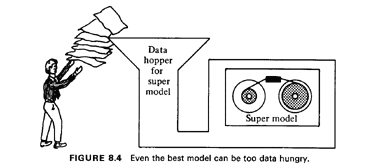


8.2.3 Data for the ModelAn important model-related attribute, a model's data requirements, can often represent major impediments to implementation. Chaiken reports in a study of urban model implementation successes and failures that the data need of a model is the most frequent model-based factor that led to failure of implementation. [CHAI 75]. One may have developed a highly efficient model, costing, say, just a few dollars per run on the computer; if, however, the cost of collecting data for the model runs in the thousands of dollars and requires months to complete, both the dollar and the time limits placed on the decision(s) at hand may be exceeded (see Figure 8.4). This factor is a highly relevant one to consider when thinking about degree of aggregation versus level of detail of a model. 
It has been our experience that for a given model, two very similar cities can incur very dissimilar data collection costs. Critical factors affecting data collection include an agency's former record keeping, both in terms of contents and of accuracy; the need for pilot data-collection efforts for new types of data; the number and types of personnel available to carry out data collection; and the amount and type of computer services required. Most often, accurate computer-encoded records also provide the least expensive and most timely data inputs. Boston's Department of Health and Hospitals has little trouble providing data for its hypercube model, since most required data are generated routinely by an on-line computer-aided dispatch (CAD) system. |